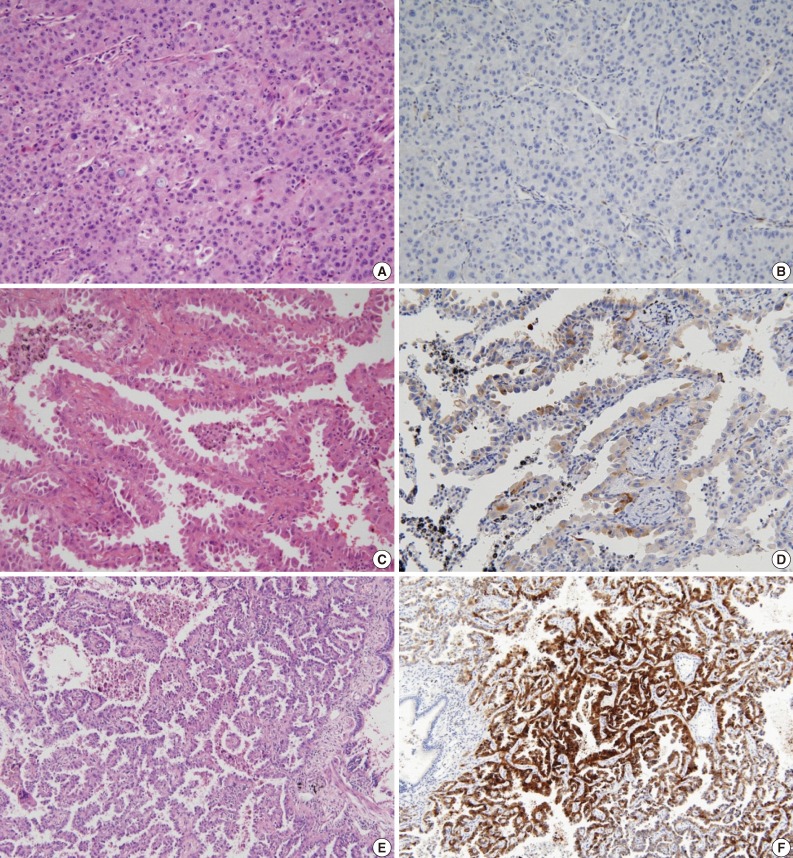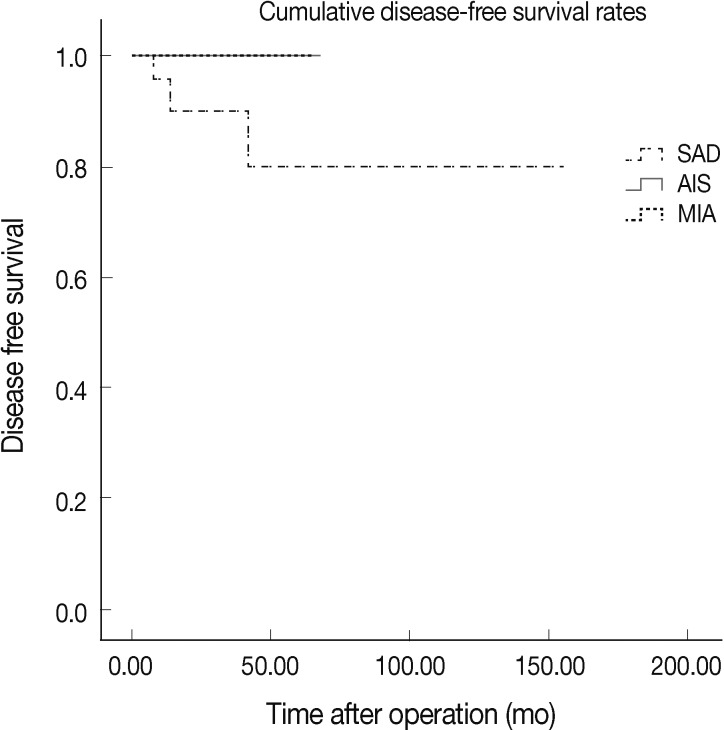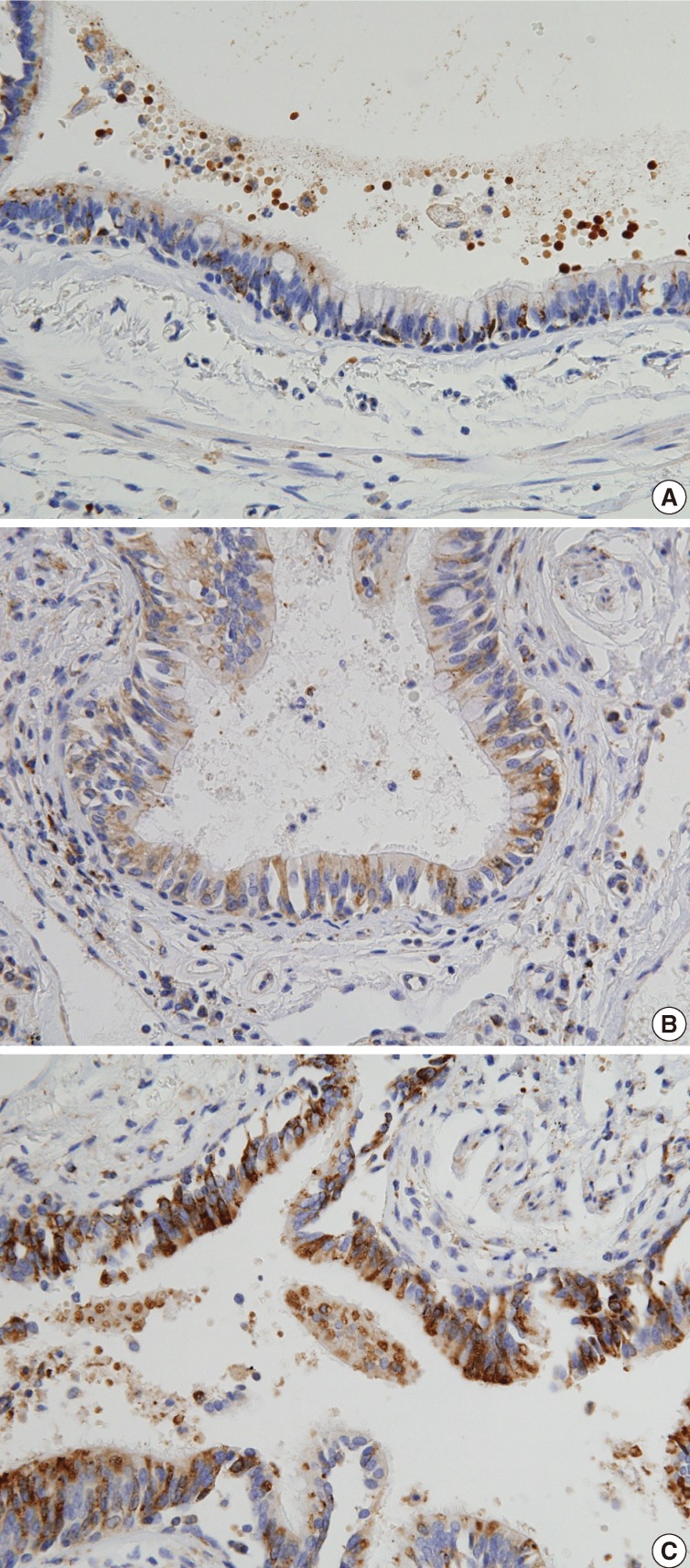Articles
- Page Path
- HOME > J Pathol Transl Med > Volume 47(3); 2013 > Article
-
Original Article
Naked Cuticle Drosophila 1 Expression in Histologic Subtypes of Small Adenocarcinoma of the Lung - Sangjeong Ahn, Won Hwangbo, Hyunchul Kim, Chul Hwan Kim
-
Korean Journal of Pathology 2013;47(3):211-218.
DOI: https://doi.org/10.4132/KoreanJPathol.2013.47.3.211
Published online: June 25, 2013
Department of Pathology, Korea University Anam Hospital, Korea University College of Medicine, Seoul, Korea.
- Corresponding Author: Chul Hwan Kim, M.D. Department of Pathology, Korea University Anam Hospital, Korea University College of Medicine, 73 Inchon-ro, Seongbuk-gu, Seoul 136-705, Korea. Tel: +82-2-920-5991, Fax: +82-2-920-6576, chkap@korea.ac.kr
© 2013 The Korean Society of Pathologists/The Korean Society for Cytopathology
This is an Open Access article distributed under the terms of the Creative Commons Attribution Non-Commercial License (http://creativecommons.org/licenses/by-nc/3.0/) which permits unrestricted non-commercial use, distribution, and reproduction in any medium, provided the original work is properly cited.
Figure & Data
References
Citations

- Challenges of the eighth edition of the American Joint Committee on Cancer staging system for pathologists focusing on early stage lung adenocarcinoma
Yu‐Ting Wang, Il‐Chi Chang, Chih‐Yi Chen, Jiun‐Yi Hsia, Frank Cheau‐Feng Lin, Wan‐Ru Chao, Tuan‐Ying Ke, Ya‐Ting Chen, Chih‐Jung Chen, Min‐Shu Hsieh, Shiu‐Feng Huang
Thoracic Cancer.2023; 14(6): 592. CrossRef - Clinical Significance of NKD Inhibitor of WNT Signaling Pathway 1 (NKD1) in Glioblastoma
Lijun Li, Ruiying Gao, Weizhong Huangfu, Fang Zhang, Ruixia Wang, Hongda Liu
Genetics Research.2023; 2023: 1. CrossRef - Naked cuticle homolog 1 prevents mouse pulmonary arterial hypertension via inhibition of Wnt/β-catenin and oxidative stress
Shanwu Wei, Lu Lin, Wen Jiang, Jie Chen, Gu Gong, Daming Sui
Aging.2023;[Epub] CrossRef - MicroRNA‐195‐5p suppresses osteosarcoma cell proliferation and invasion by suppressing naked cuticle homolog 1
Qiang Qu, Xiangdong Chu, Peng Wang
Cell Biology International.2017; 41(3): 287. CrossRef - Downregulation of NKD1 in human osteosarcoma and its clinical significance
Xiang Chen, Ping Xu, Jianwei Zhu, Fan Liu
Molecular Medicine Reports.2017;[Epub] CrossRef - Lung Adenocarcinoma Staging Using the 2011 IASLC/ATS/ERS Classification: A Pooled Analysis of Adenocarcinoma In Situ and Minimally Invasive Adenocarcinoma
Madhusmita Behera, Taofeek K. Owonikoko, Anthony A. Gal, Conor E. Steuer, Sungjin Kim, Rathi N. Pillai, Fadlo R. Khuri, Suresh S. Ramalingam, Gabriel L. Sica
Clinical Lung Cancer.2016; 17(5): e57. CrossRef - The NKD1/Rac1 feedback loop regulates the invasion and migration ability of hepatocarcinoma cells
Jie Li, Sheng Zhang, Qing Hu, Kang Zhang, Jianbin Jin, Xuqing Zheng, Zhenyu Yin, Xiaomin Wang
Scientific Reports.2016;[Epub] CrossRef - NKD1 correlates with a poor prognosis and inhibits cell proliferation by inducing p53 expression in hepatocellular carcinoma
Sheng Zhang, Jie Li, Xiaomin Wang
Tumor Biology.2016; 37(10): 14059. CrossRef - Expression pattern and clinicopathologic significance of NKD1 in human primary hepatocellular carcinoma
Sheng Zhang, Jie Li, Zhen‐Yu Yin, Ping‐Guo Liu, Wen‐Xiu Zhao, Cheng‐Rong Xie, Bi‐Xin Zhao, Xiao‐Min Wang
APMIS.2015; 123(4): 315. CrossRef - Early lung cancer with lepidic pattern
Wilko Weichert, Arne Warth
Current Opinion in Pulmonary Medicine.2014; 20(4): 309. CrossRef - Altered Expression of PTEN and Its Major Regulator MicroRNA-21 in Pulmonary Neuroendocrine Tumors
Hyoun Wook Lee, Seung Yeon Ha, Mee Sook Roh
Korean Journal of Pathology.2014; 48(1): 17. CrossRef - The New 2011 International Association for the Study of Lung Cancer/American Thoracic Society/European Respiratory Society Classification of Lung Adenocarcinoma in Resected Specimens: Clinicopathologic Relevance and Emerging Issues
Seung Yeon Ha, Mee Sook Roh
Korean Journal of Pathology.2013; 47(4): 316. CrossRef
 PubReader
PubReader ePub Link
ePub Link-
 Cite this Article
Cite this Article
- Cite this Article
-
- Close
- Download Citation
- Close
- Figure



Fig. 1
Fig. 2
Fig. 3
| AIS (n = 5) | MIA (n = 8) | SAD (n = 27) | |
|---|---|---|---|
| Mean age (range, yr) | 55.4 (49-60) | 58.5 (43-76) | 60.9 (30-79) |
| Gender (male/female) | 3/2 | 3/5 | 12/15 |
| Smoking status | |||
| Never-smoker | 3 | 6 | 20 |
| Ever-smoker | 2 | 2 | 7 |
| Gross size (mean) | 0.9 ± 0.2 (0.7) | 1.05 ± 1.05 (0.83) | 1.35 ± 0.65 (1.42) |
| Invasive size (mean) | 0 | 0.3 ± 0.15 (0.4) | 1.35 ± 0.65 (1.37) |
| Predominant invasive pattern | |||
| Acinar, papillary | N/A | 6/2 | 19/4 |
| Micropapillary | N/A | 0 | 0 |
| Solid | N/A | 0 | 4 |
| Nodal metastasis | |||
| Yes | 0 | 0 | 2 |
| No | 2 | 6 | 24 |
| Not available | 3 | 2 | 1 |
| Lymphatic invasion | 0 | 0 | 1 |
| Tumor necrosis | 0 | 0 | 1 |
| Follow-up | |||
| Mean time (mo) | 28.2 | 35.0 | 35.6 |
| Range time (mo) | 11-68 | 13-45 | 1-156 |
| DOD | 0 | 0 | 3 |
| AFD | 5 | 8 | 23 |
| Total (n = 40) | NKD1-reduced (n = 8) | NKD1-normal (n = 15) | NKD1-overexpressed (n = 17) | p-value | |
|---|---|---|---|---|---|
| Age (yr) | 0.506 | ||||
| < 61 | 22 (100) | 3 (13.7) | 8 (36.3) | 11 (50) | |
| ≥ 61 | 18 (100) | 5 (55.6) | 7 (38.9) | 6 (33.3) | |
| Gender | 0.075 | ||||
| Male | 17 (100) | 4 (23.5) | 3 (17.6) | 10 (58.8) | |
| Female | 23 (100) | 4 (17.3) | 12 (52.1) | 7 (30.4) | |
| Smoking status | 0.473 | ||||
| Never-smoker | 29 (100) | 5 (17.2) | 10 (34.5) | 14 (48.3) | |
| Ever-smoker | 11 (100) | 3 (27.2) | 5 (45.5) | 3 (27.3) | |
| Pathologic T stage status | 0.189 | ||||
| pTis | 5 (100) | 0 (0) | 4 (80) | 1 (20) | |
| pT1a | 35 (100) | 8 (22.9) | 11 (31.4) | 16 (45.7) | |
| Nodal metastasis | 0.003 | ||||
| Yes | 2 (100) | 2 (100) | 0 (0) | 0 (0) | |
| No | 32 (100) | 4 (12.5) | 11 (34.4) | 17 (53.1) | |
| N/A | 6 (100) | 2 (33.3) | 4 (66.6) | 0 (0) | |
| Histologic subtype | 0.409 | ||||
| AIS | 5 (100) | 0 (0) | 4 (80) | 1 (20) | |
| MIA | 8 (100) | 2 (25) | 3 (37.5) | 3 (37.5) | |
| SAD | 27 (100) | 6 (22.2) | 8 (29.6) | 13 (48.1) | |
| Predominant histologic pattern | 0.316 | ||||
| Lepidic | 13 (100) | 2 (15.4) | 7 (53.8) | 4 (30.8) | |
| Acinar | 19 (100) | 5 (26.3) | 6 (31.6) | 8 (42.1) | |
| Papillary | 4 (100) | 0 (0) | 0 (0) | 4 (100) | |
| Solid | 4 (100) | 1 (25) | 2 (50) | 1 (25) |
| Total (n = 40) | NKD1-reduced (n = 8) | NKD1-normal (n = 15) | NKD1-overexpressed (n = 17) | p-value | |
|---|---|---|---|---|---|
| Lepidic predominant | 13 (100) | 2 (15.4) | 7 (53.8) | 4 (30.8) | 0.347 |
| Non-lepidic predominant | 27 (100) | 6 (22.2) | 8 (29.6) | 13 (48.1) | |
| Acinar predominant | 19 (100) | 5 (26.3) | 6 (31.6) | 7 (36.8) | 0.599 |
| Non-acinar predominant | 21 (100) | 3 (14.3) | 9 (42.9) | 10 (47.6) | |
| Papillary predominant | 4 (100) | 0 (0) | 0 (0) | 4 (100) | 0.026 |
| Non-papillary predominant | 36 (100) | 8 (22.9) | 15 (42.9) | 13 (34.3) | |
| Solid predominant | 4 (100) | 1 (25) | 2 (50) | 1 (25) | 0.821 |
| Non-solid predominant | 36 (100) | 7 (19.4) | 13 (36.1) | 16 (44.4) |
| Poor prognostic factors | p-value |
|---|---|
| Nodal metastasis | 0.001 |
| Presence of micropapillary pattern | 0.001 |
AIS, adenocarcinoma Patients who died of SAD were calculated as 3, after exclusion of one patient who died 14 days after surgery.
Values are presented as number (%). NKD1, naked cuticle Drosophila 1; N/A, not available; AIS, adenocarcinoma
Values are presented as number (%). NKD1, naked cuticle Drosophila 1.

 E-submission
E-submission








